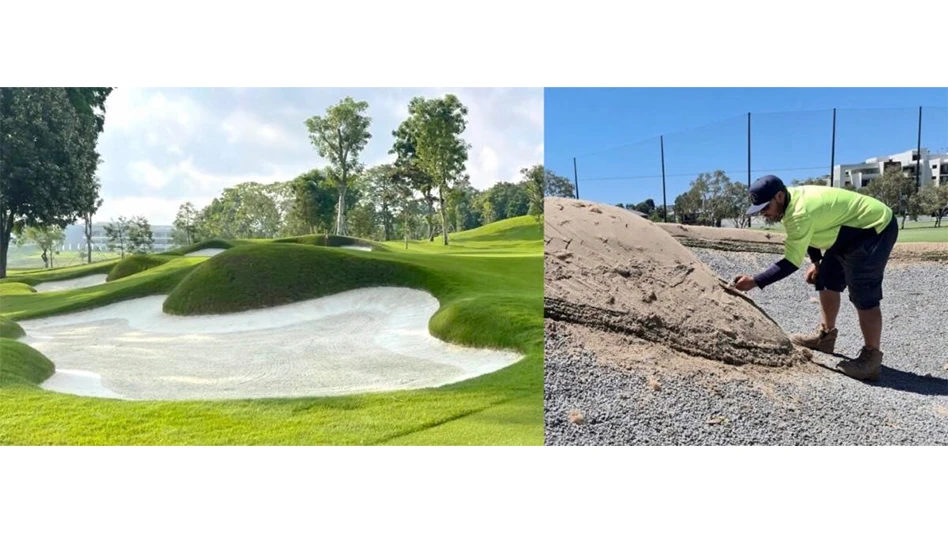 It’s no secret the key with anthracnose is stress. If turf is stressed, it opens the door for the disease to come in and go for the kill. It’s exactly for this reason that Frank Wong says his “pathological spidey sense” is telling him this year is going to be a bad one for anthracnose.
It’s no secret the key with anthracnose is stress. If turf is stressed, it opens the door for the disease to come in and go for the kill. It’s exactly for this reason that Frank Wong says his “pathological spidey sense” is telling him this year is going to be a bad one for anthracnose.
“If you look at this last winter, there’s a lot of environmental stress on those plants,” says Wong, technical service specialist for Bayer Environmental Science. “Anthracnose is particularly hard on annual bluegrass, and a lot of it has taken a heavy beating this winter. If your annual bluegrass is ‘farkakte,’ it may be at high risk for anthracnose to come in and finish it off.”
The region Wong believes is most at risk is the Midwest, based on the “polar vortex” and ice damage and winter kill. And he goes one step further to say the form of anthracnose that will likely be seen this spring is basal rot, which tends to come in on plants with damaged crowns and stems and is considered more virulent than foliar anthracnose.
“Crown infections tend to occur in cold, wet conditions, leading to basal rot,” Wong says. “Once you get basal rot, the changes of recovery are low.”
Anthracnose is a stress disease and develops under “extreme” environmental conditions. On the flip side, dry, hot weather can induce stress as well and make plans susceptible to anthracnose. Wong cites the example of California this year. While it has received some rain, it is still experiencing severe drought conditions which will probably open the door for anthracnose.
As superintendents go into winter dormancy, they undoubtedly cross their fingers and hope to have a mild winter. With that out the window this year, there’s not much that can be done when a course is buried under 6 inches of snow and ice. It’s a waiting game until, temperatures rise, everything thaws out and plant growth resumes.
|
Key points
|
After a stressful winter, Wong recommends embarking on an early preventative fungicide program.
“You should go on this program as early as possible, especially in winter-damaged areas,” he says. “Also, make sure you apply adequate fertilizer in the spring to promote active plant growth and recovery.”
Research from the Rutgers School of Environmental and Biological Sciences and the New Jersey Agricultural Experiment Station seems to support Wong’s assertion about nitrogen, at least on annual bluegrass putting greens. Its current findings indicate that nitrogen fertilization is “the most influential cultural practice affecting anthracnose severity in annual bluegrass putting green turf. Nitrogen deficient turf predisposes turf to anthracnose and compromises its ability to recuperate from disease damage. Other practices that we have studied such as mowing height, topdressing, foot traffic, irrigation, lightweight rolling and the application of plant growth regulators can also affect this disease.”
Wong’s other recommendation is to show plenty of patience and “TLC” with your turf because the last thing you want to do is put it under more stress.
“If you want summer U.S. Open conditions right out of the gate in the late-winter or early spring, and put that stress on your turf, you may be setting yourself up for anthracnose,” he says.
“Have patience, show your turf TLC, and let it recover and get reestablished and then put stress on it later when it’s ready for it.”
|
Don't rule out Bayer’s Frank Wong also cautions to not forget about other diseases like Pythium root rot, Microdochium patch are worse in the Spring on winter-injured turf. In addition, pay attention to air and soil temperatures rather than a calendar-based program as they are more reliable indicators of when to enact disease management strategies. “If you base your management programs strictly on a calendar instead of environmental conditions, you can miss a critical disease control window and be behind the 8-ball for a long time,” he says. |
Matt Giese, regional technical manager for the Midwest for Syngenta, has kept a close eye on the United States Drought Monitor and feels that temperatures have been the most significant characteristic of this winter. There have been areas on the East Coast that have received significant amounts of precipitation, whether it be rain or snow, but the story has been entirely different in other parts of the country.
“Yes, it has been a harsh winter, but in some areas it has been a dry winter. A lot of areas may not have recovered from previous summer moisture conditions,” he says. “So as we move into the spring months, that can be a key factor as to what level of severity anthracnose and ultimately some other diseases that also require moisture manifest themselves.”
Predicting anthracnose pressure based on winter conditions as a crystal ball question.
“It’s difficult to answer, but there is research that says cold temperatures will affect disease pathogens such dollar spot, anthracnose, et cetera,” Giese says. “It might reduce maybe the number of pathogens that might be isolated out of a particular area, but does it reduce the severity going into spring? It’s hard to answer. Once you have disease in an area, it resides in that plant debris, maybe even the thatch area. And so, at least with anthracnose, it requires some sort of stress in the plant to manifest or activate its symptoms. There is a germination or incubation period for overwintering structures, so once it detects the stress in the plant we see the symptoms on leaves, roots or in the crown.”
According to Giese, anthracnose severity is more dependent on spring conditions and whether there is continued moisture and what sort of stressful events might occur.
“Clearly, there are some cultural practices that can beat up the turf a little, and that’s a normal part of the turf life cycle, but it’s more dependent on spring conditions – if it continues to stay wet, how long the leaf stays wet during the day, if we have cold conditions, etc.”
Giese says that if the spring is cool and wet and you have poor drainage areas, it will be those areas you want to check first as they are hot spots where you might see anthracnose initially. But he admits that sometimes anthracnose is not temperature-related.
“I have seen where even in February we saw anthracnose active on putting greens, so it certainly isn’t waiting for 70-degree temperatures,” he says. “The key factor is moisture, especially in poorly drained areas or areas that have compaction because they weren’t aerified. Or maybe it didn’t receive the last round of fertilization so there are nutritional deficiencies as well. It’s all of those things working together and creating this mutual stress on the plant, and that’s where we see anthracnose survive and continue to cause problems.”
Basal rot anthracnose is more likely to occur when the soil is saturated with moisture. If you have drier conditions on the surface then you have less leaf wetness, so foliar anthracnose is less likely in that scenario but not exclusive. But Giese admits you could also have both foliar and basal rot anthracnose at the same time.
“You could have wet conditions above and below the surface that could make the plant more susceptible to infection, especially if it’s under stress,” Giese says.
If you have a well-drained soil profile but have continuous dew or leaf moisture and this situation occurs for a long time, it’s possible you could only get foliar anthracnose.
“Sometimes it will stay foliar and sometimes it will turn into basal,” says Giese. “It depends on what environmental conditions and parameters might be occurring.”
For treatment, Giese prefers AI combo fungicides like Headway, Concert or Strata. Snow mold applications contain three different AI that can also be used against anthracnose in spring. In the Central Plains and Great Lakes, snow mold apps made in the fall can sometimes carry over into spring.
 “It’s one application and done, but it sort of helps set the stage to be a bit more ready to start those spring applications and allows you to be one step ahead of the disease curve,” Geise says. “It ends up being a more preventative approach if you can get ahead of the turf. And then it also gives you broad spectrum activity against a plethora of other diseases in that early spring timeframe.”
“It’s one application and done, but it sort of helps set the stage to be a bit more ready to start those spring applications and allows you to be one step ahead of the disease curve,” Geise says. “It ends up being a more preventative approach if you can get ahead of the turf. And then it also gives you broad spectrum activity against a plethora of other diseases in that early spring timeframe.”
Many pathologists, Giese says, recommend applications at least a month prior to when you expect to see symptoms. For example, if you typically see symptoms in late June, then you would apply in mid- to late-May.
“Be prepared. If you have areas historically were hit with anthracnose, have a spray program ready. Be prepared to make the first application even if it seems it may be earlier than the previous year. The reason is it’s much easier to be on a preventative program and get better control with that approach than waiting till you see symptoms and then use rescue treatments to manage the disease.”
Jason Stahl is a Cleveland-based writer and a frequent GCI contributor.
For more
Looking for more info on anthracnose? Enter bit.ly/1gKk12O into your browser to hear Dr. Karl Danneberger talk about how to spot anthracnose in the wild and control it with cultural practices in this Ohio State University Turfgrass series.

Explore the April 2014 Issue
Check out more from this issue and find your next story to read.
Latest from Golf Course Industry
- Bloom Golf Partners adds HR expert
- Seeking sustainability in Vietnam
- Kerns featured in Envu root diseases webinar
- Toro continues support of National Mayor’s Challenge for Water Conservation
- A different kind of long distance
- Golf Construction Conversations: Stephen Hope
- EnP welcomes new sales manager
- DLF opening centers in Oregon, Ontario





